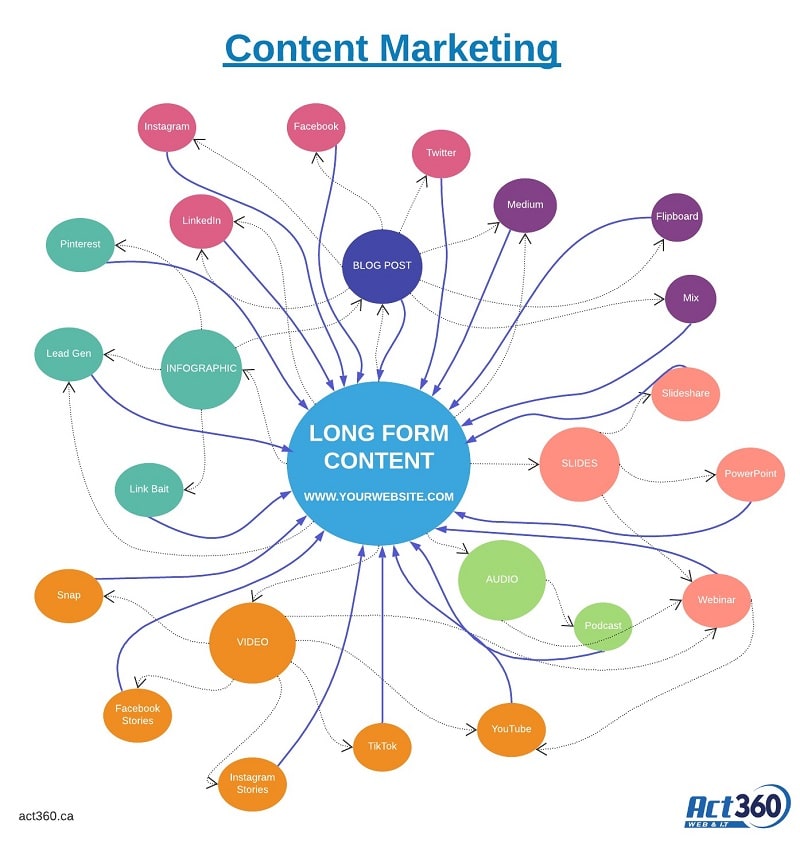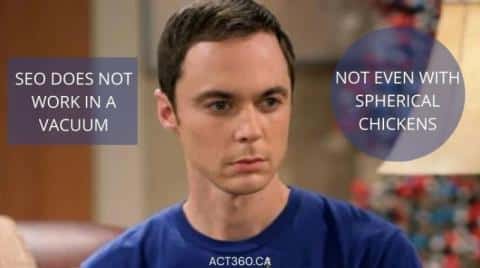True story. No amount of physics can change the fact that SEO does not work in a vacuum … as a stand-alone strategy. SEO is just one piece of a much larger digital marketing plan.
Think of it like this:
A flashlight is useless without batteries. And the batteries are useless unless they’re in the flashlight. And even once you put the batteries inside the flashlight, you still need a hand to push the power button. And to point the light in the right direction.
Without all the necessary elements working cohesively together, you’re left in the dark.
Worse, if left unattended, the batteries will eventually run out and the flashlight will die.
The same is true of SEO. It’s needs outside help to make it work, and it requires constant recharging to maintain its power.
Again … SEO does not work in a vacuum.
Sadly, this is where I see so many businesses fail in their marketing journey.
So What Exactly Is SEO?
Is it XML sitemaps and robots.txt files? Is it keywords, meta data and blog posts? Is it link building?
Yes, yes and yes. But a lot more goes into SEO than meets the eye. I’ve been using a 3-phased approach to SEO for more than a decade. Over the years, I’ve tested it and tweaked it, and I’ve watched it work time and time again for dozens of clients.
Today I’m sharing my best-kept secret.
3-Phased Approach to Successful (Long-lasting) SEO

Phase I: Research & Review
Timeframe: 1 month
This is the phase where we learn about your business. We learn about your competitors. We learn about your industry, goals and audience. We learn everything there is to know about you. The only way we can help is if we understand where you are today and where you want to be tomorrow.
During the research phase, we will:
- Perform a comprehensive website audit to uncover technical issues holding your sight back from positioning well in search engine results pages (SERPs). Things like 404 errors, broken links and page load speed. We look at schema markup, mobile friendliness and incoming links. And we look at on-page factors such as meta data, content and the over all user experience.
- Perform keyword research – not so we can stuff your pages full of words we think Google wants to see, but to get inside the heads of your customers to understand how they’re searching for products and services like yours. We look for trends in the market, and we look at user intent. We look at search volume and ranking difficulty (how competitive is a keyword phrase?). The we pull all the information together to map out keyword themes that match the goal of the web page with the user intent behind the keyword theme.
- Review competitive landscape – we look at what’s happening in your industry. Who are your main competitors? What are they doing right with their SEO, and where are their gaps? How are they marketing themselves in your space? And where are the opportunities to ethically kick ‘em to the curb?
Phase II: Clean Up & Strategize
Timeframe: 2 months
Phase two typically takes about 45-60 days (unless you have an ecommerce site of 10,000+ pages, in which case we’d need to map out a long-term plan to coordinate Phase II in tandem with Phase III).
Now that we have all this juicy information about your business, your clients, your competition, you’re your goals, we can begin clean-up.
We’ll start to fix all those small technical issues and we’ll clean up existing web pages, so they’re properly optimized to deliver the best user experience, while satisfying Google’s needs, too.
In this phase, we:
- Map head and torso keyword themes to existing pages
- Optimize on-page elements to incorporate keyword variations in power positions
- Check internal and external linking
- Rewrite and test calls to action
- Review customer buy flow experience (ie: do forms work properly, is it easy for me to get the information I want, and did I naturally take the desired action?)
At the same time, our content team will begin strategizing new and interesting ways to drive targeted traffic to your site.
This where many businesses get tripped up. They think SEO is about technical behind-the-scenes stuff – just set it and forget it. Sure, that’s part of it, but there’s so much more … which brings us into Phase III.
Phase III: Create & Promote Content
Timeframe: 12+ months
This is the ongoing phase. It’s the long game. To stay ahead of the competition and dominate the SERPs, you need to continually serve valuable content to your audience. That’s the only way to build trust and keep them coming back for more.
Did you know …
It takes at least 7 interactions to turn a prospect into a customer.
Why? You’re asking people to part with their most prized possession – CASH. That takes time.
People buy from people they like. They buy from people they trust. And trust is not built in a day.
Like any other relationship, trust takes time to build. It needs to be nurtured … slowly.
How do you build trust?
- Be there with answers to their questions
- Be there will helpful solutions to their problems
- Be there with the content they need when they need it
- Be there with a friendly smile and open arms
- And do it all without asking for the sale
That’s how you build trust and stay top of mind. When consumers are ready to open their wallets, you want them to think of you with confidence.
Here’s how we do it:

The Content Marketing Lifecycle
- Start with a base piece — maybe a how-to guide, case study or whitepaper.
- Next, create PowerPoint slides to showcase the content
- Design an infographic with visual representations of the content
- Record a video discussing the topic
- Transcribe the video into blog post
- Promote the blog post on content curation sites
- Break out the blog post into small bits of information to share on social media channels
- Design “right-sized” images and memes for social media distribution
- Transform the blog post into an email marketing offer
- … you get the idea.
Content is the Lifeblood of Your Website
Just like your flashlight is useless without batteries, your website is useless without content.
SEO, blog posts, email, social media — they are the nuts and bolts of a larger digital marketing machine. Each component relies on another to keep it running efficiently.
Once you learn how to repurpose one large piece of content into dozens of smaller pieces of content, you’ll quickly realize that content marketing is not so overwhelming.
Still, you have a business to run, and content marketing may not be your forte. That’s OK, well all have our own lanes. Focus on what you do best and leave the rest to the experts.
Let’s see if our digital marketing pros can help you convert prospects into long-lasting customers.
Book your no-cost, no-obligation consult today. Don’t worry, we won’t ask you for any money – we just want to find out if we can help.
And if you found this post helpful, we’d be super grateful if you’d like and share it with others.

